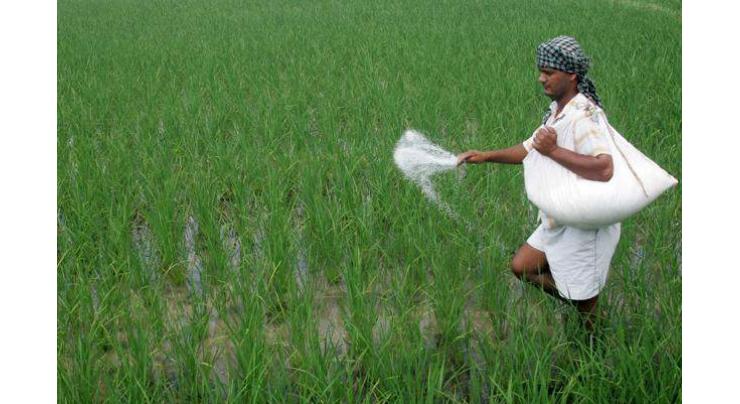
Impact Of Fertilizer Subsidy Scheme
Mohammad Ali (@ChaudhryMAli88) Published February 13, 2018 | 11:46 PM

Reduction in the cost of production to make agriculture profitable is a major challenge. All out efforts have been made by government to facilitate the farmers by decreasing input prices through curtailment of GST, provision of cash subsidies and cheaper feed gas for the fertilizer industry. This reduction in prices, especially of fertilizers, has been widely applauded by the farming community.
ISLAMABAD,(UrduPoint / Pakistan Point News - 13th Feb, 2018) : Reduction in the cost of production to make agriculture profitable is a major challenge. All out efforts have been made by government to facilitate the farmers by decreasing input prices through curtailment of GST, provision of cash subsidies and cheaper feed gas for the fertilizer industry.
This reduction in prices, especially of fertilizers, has been widely applauded by the farming community. In the Federal Budget 2017-18, it was decided to maintain prices of Urea up to 1400 per bag, it was also decided at a high level meeting held in the Prime Minister's office, on 24-01-2017 that the fertilizer subsidy scheme will remain a Federal Government initiative.
Later, it was decided that cash subsidy on Urea fertilizer @Rs. 100/• per bag will be provided, after sales on the basis of sales tax invoice and sales tax returns submitted by the manufacturers to Federal board of Revenue (FBR). The fertilizer industry supported Govt’s initiative, however, has been running from pillar to post for subsidy payments, that are haunting the industry for last two years.
It is learnt that a committee had been constituted under the chairmanship of Federal Minister of NFS&R to address the anomalies in fertilizer subsidy scheme, and examine viability of proposal for substituting the existing cash subsidy with elimination / reduction of sales tax on fertilizers.
The fertilizer industry has taken up case with the Ministry that its viewpoint be taken into account before taking a decision on the proposal. It may be understood that subsidy on Urea is not to benefit the industry but the farmers.
Hence, the substitution of subsidy with reduction of GST on Urea will have implications for both and must be understood. The reduction of GST on Urea from 5% (Rs. 70 per bag) to 2% (Rs.
28 per bag) will prima facie lead to reduction of end selling price by Rs. 42 per bag. However, elimination of Rs. 100 cash subsidy will lead to increase in price by Rs. 58 per bag (100-42=58), thus nullifying the impact of GST reduction, unless the high cost of production is reduced, since the gas prices in Pakistan are much higher than international industry (USD 4.65 per MMBTU in Pakistan against USD 1.3 to 3 per MMBTU in middle East/USA). The industry has already absorbed PKR 106 per bag in the recent times since the subsidy regime was introduced to support the farmer community.
It would be recalled that subsidy was reduced from PKR 156 to 100 in 2017/18 and it alone necessitated the industry to absorb PKR 6.72 billion, not mentioning the cost of financing required due to delayed subsidy payments and earlier contribution of approximately Rs 6 Billions during FY 2016/17.
With the elimination of subsidy, the Industry will be within its rights to recover the above-mentioned loss of PKR 106 per bag, and hence we foresee the adjustment in urea sales price. The mismatch of input and output GST on urea, if output GST is reduced to 2% , (output will be Rs.
26 against input of Rs. 114 per bag) will lead to serious financial implications for the fertilizer industry due to further piling up of tax refunds/adjustable. Presently, the input taxes vary from 5 to 17 percent, hence, over Rs 14 Billion are already awaiting adjustment/refund.
Related Topics
Recent Stories

Experts raise concerns over introduction of 10-stick packs

Iranian president arrives in Karachi

Law Minister expresses Govt's resolve to address issue of missing persons

Rizwan’s batting order may be changed: Sources

Nawaz Sharif to visit Guangzhou exhibition in China

FM Dar not traveling to China: Foreign Office

PM takes notice of deliberate delay in tax cases

Iranian President visits Allama Iqbal’s mausoleum

Iranian President arrives in Lahore today

Currency Rate In Pakistan - Dollar, Euro, Pound, Riyal Rates On 23 April 2024

Today Gold Rate in Pakistan 23 April 2024

Islam enlightened world with its teachings about knowledge: Dr Jamileh
More Stories From Agriculture
-

Livestock dept, PCS to hold poultry expo from April 30
6 days ago -

Farmers advised to adopt pre, post harvest management for wheat crop
7 days ago -

Farmers must complete all arrangements prior to wheat harvesting
10 days ago -

Wheat Harvest: Agri deptt issues certain guidelines
10 days ago -

1,800 agricultural equipment to be provided to 710 farmers: secretary
17 days ago -

Steps must be taken for promotion of agriculture sector in Balochistan: Qadir
17 days ago
-

Govt working to increase agriculture production in merged districts: KP Minister
18 days ago -

Commissioner chairs meeting to discuss wheat procurement target, other matters
21 days ago -

Vital for economy, agriculture sector to be uplifted on priority basis: Minister
1 month ago -

Advisory for wheat growers
1 month ago -

Secretary Agriculture says govt providing financial support for wheat seed to flood hit farmers
1 month ago -

Int'l training workshop on 'Irrigation System & Water Management starts
2 months ago











